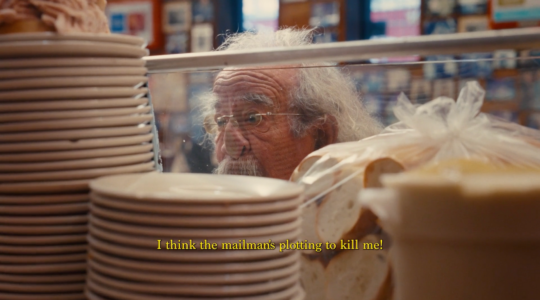It’s a rather odd admission for a director whose first feature film is a ground-breaking documentary about the Holocaust, but growing up in Israel, Yael Hersonski avoided films about the Shoah and memorial sites like Yad Vashem. She had a much more vivid reminder of the events at home.
“My grandmother, my mother’s mother, lived in Poland and survived the war,” says the 34-year-old filmmaker whose new work, “A Film Unfinished,” opens on August 18. “The fact of my grandmother’s existence reminded me of what happened. It was all folded into her face. I thought all these sites and films were mediating something I didn’t need to mediate, because I had my grandmother.”
She invokes the touchstone for many documentarians dealing with the murder of six million European Jews, Claude Lanzmann.
“Lanzmann says that as long as the witnesses are alive, their memories are something no document can describe,” Hersonski says. “[My grandmother’s] very existence is powerful, for me it’s enough. I couldn’t be closer to what happened than by being with her.”
But when Hersonski’s grandmother died, it presented her with a dilemma her film background left her well-suited to address.
“After she died, I faced a new reality,” she admits. “Her absence was one of the things that pushed me into the archives. And I started to reflect on what the archive can show us and what it can’t show us.”
For Hersonski, this is not merely an academic concern. For three years she was content editor for documentaries for Israel’s Channel 10, a job that forced her to think hard about how viewers process images intellectually. The dismay with which she views that mental process is reflected directly in “A Film Unfinished,” as she is quick to point out.
While she was at Channel 10, she explains, “I started to think about how we are incapable of understanding what we are seeing because we are bombarded by so many images of atrocities all over the world, including our own explosive region. We can’t see anymore because of the quantity of images and because of the mediation,” that is, the way that these images are selectively shown to us.
“I wanted to go back to a starting point, where it all emerged as a systematic way of documenting what is happening,” she says. What she ended up doing, ironically, actually requires the deconstruction of a series of highly mediated images, presented by the most manipulative propaganda machine of the 20th Century, that of the Nazis.
Then she learned of a little-known Nazi propaganda project that fit her needs perfectly. It was an unfinished movie about the Warsaw Ghetto, shot on location in the ghetto in May 1942, an eerie mixture of documentary footage and staged scenes designed to foster maximum anti-Semitic reactions from an audience. There was a 62-minute silent rough cut, found in an East German archive in 1954 in a can simply marked “Ghetto.” The soundtrack was either lost or destroyed, although there is evidence in the files that one was recorded.
“Filmmakers recycle what has been done before,” Hersonski says. “For years we saw images from this film that were used in other films. They describe poverty and people dying in the ghetto.”
But no one had dared show the entire film, in part because of the staged scenes that show “rich Jews” dining out festively while their poor compatriots are literally dying in the streets.
Support the New York Jewish Week
Our nonprofit newsroom depends on readers like you. Make a donation now to support independent Jewish journalism in New York.
“There was a great deal of fear of showing that footage,” Hersonski says. “The world might actually believe that some of the Jews in the ghetto lived like that. Certainly there were people who exploited the poor, even in a prison like the Warsaw Ghetto; that happens in every society. But nothing like the scenes the Nazis staged for the film.”
Before she had even known the footage existed, Hersonski had written a short theoretical essay on the role of the archive as a kind of unique historical witness, one that could only have come into being in the 20th Century, the century of film. Now she had a vehicle to explore those ideas. She even had witnesses who would attest to the conditions of the film’s creation: a half-dozen of the ghetto diaries that had survived the final liquidation remarked on the filmmakers’ presence and activities in May, 1942. Additionally, there were a few survivors still alive who remembered the events of the time, even though they had been children then, who appear in “A Film Unfinished,” watching and commenting on the Nazi footage in a screening room.
Finally, and most remarkably, there was Willy Wist.
Wist had been one of the cameramen working for the Nazis on the film. In the 1970s when German prosecutors were building a case for war crimes against the Warsaw commanders, they had deposed Wist, who spoke at length about his work there. His testimony, read by an actor because Wist himself died in 1999, gives the film a secondary armature around which Hersonski builds a level of criticism of the film’s images.
“A cameraman decides how to frame a shot, who and what will be on the screen,” Hersonski notes. “But he cannot control the expression of the face of someone looking into the camera. Their gaze is entirely their own, it cannot be conquered by cinematic manipulation. There are elements of reality that the filmmakers cannot control. I try to show these images through that perspective. That is why I emphasize every moment [of the Nazi footage] in which someone is looking into the camera. At that moment, no matter what they are doing or what is being done to them, they are implicitly saying, ‘I’m still alive. I’m fighting.’ ”
In that way, she says, she is making a complex cinematic document that “releases its reality from the image.” Given that most of the extant cinematic images of the Shoah were made by the perpetrators, this is a principle of unparalleled significance. While the film doesn’t entirely succeed at the task – there are probably a few too many elements for Hersonski to control – it is one of the rare Holocaust documentaries that is cognizant of the existence of the problem and attempts to address it.
“The image contains two elements,” Hersonski concludes, “the culpability of the cameraman who controls the frame, and the reality which cannot be controlled ever. I want audiences to see the line that separates them.”
“A Film Unfinished” opens on Wednesday, August 18 at Film Forum (209 W. Houston St.). For information, phone: 212-727-8110 or go to www.filmforum.org. It will also open August 18 at Lincoln Plaza Cinemas (62nd St. and Broadway); phone: 212 757-2280; http://www.lincolnplazacinema.com
The New York Jewish Week brings you the stories behind the headlines, keeping you connected to Jewish life in New York. Help sustain the reporting you trust by donating today.




